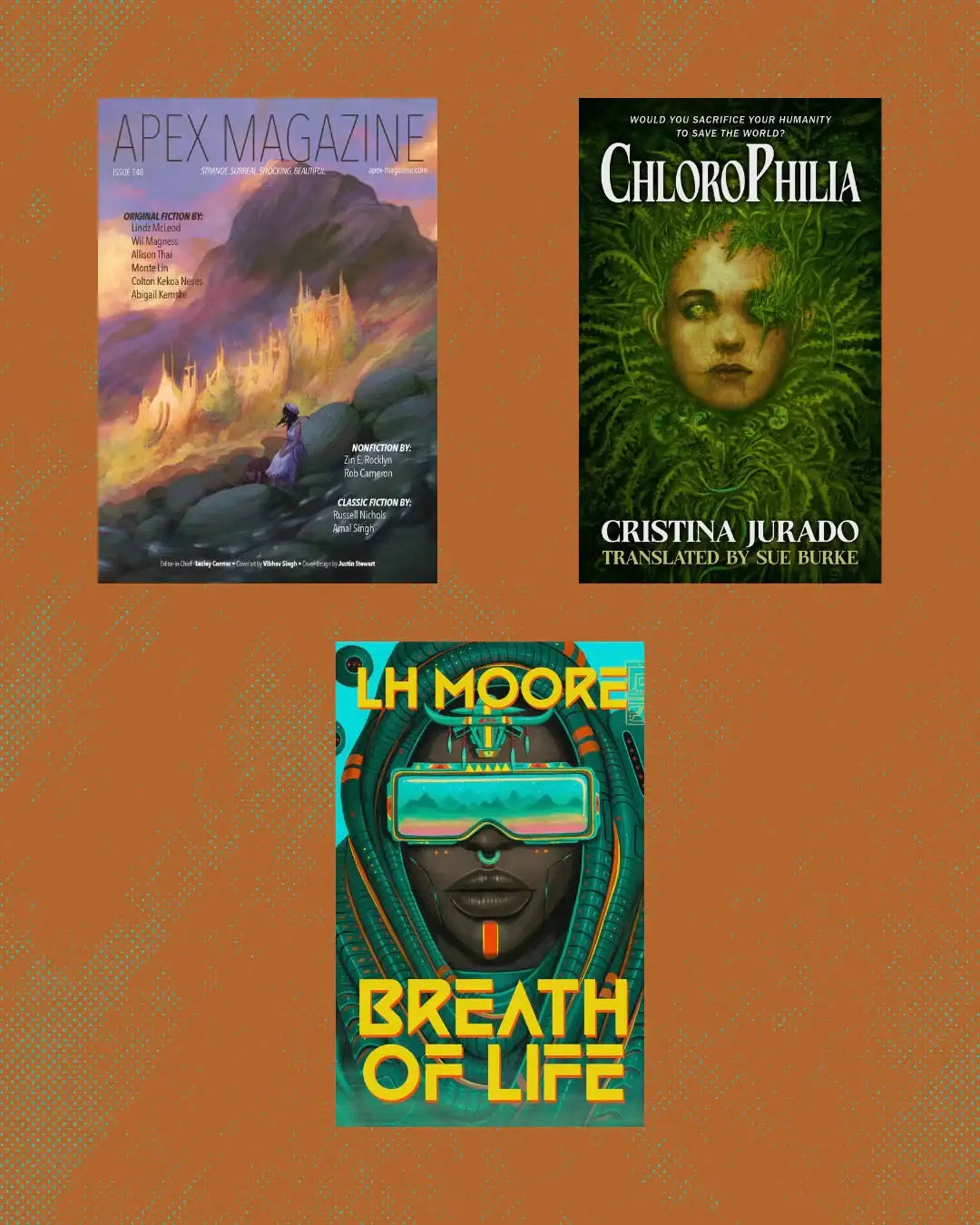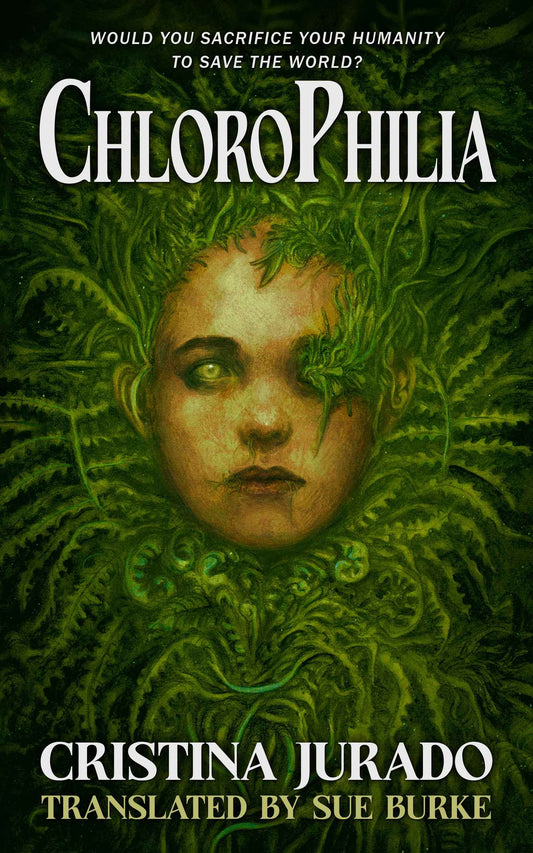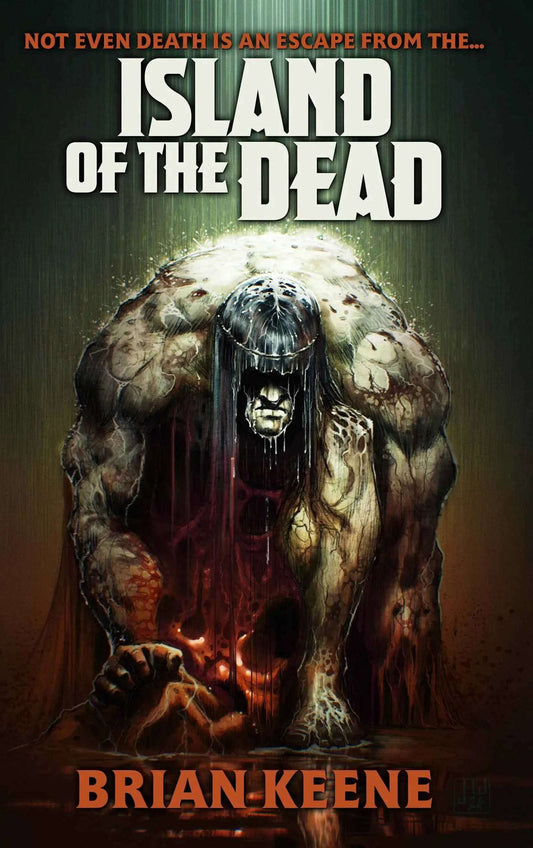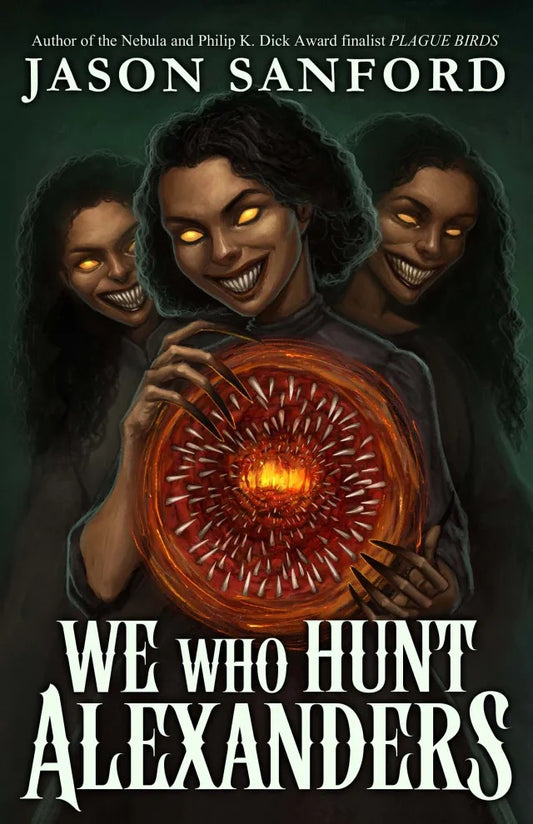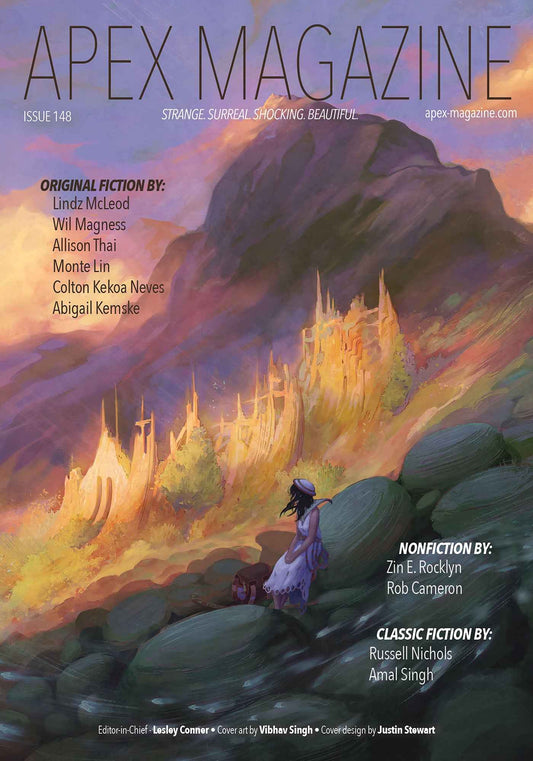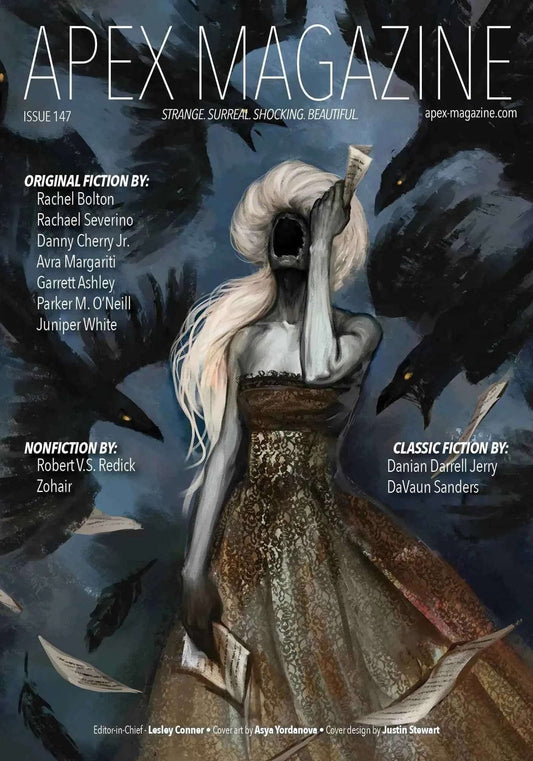
“Becoming” by Lauren Raye Snow is the cover of this month's issue of Apex Magazine, leading the issue with a dichotomy of beauty and disturbance. Lauren Raye Snow is an artist and designer from South Texas who explores odd, unexplainable, and anxious feelings in her work.
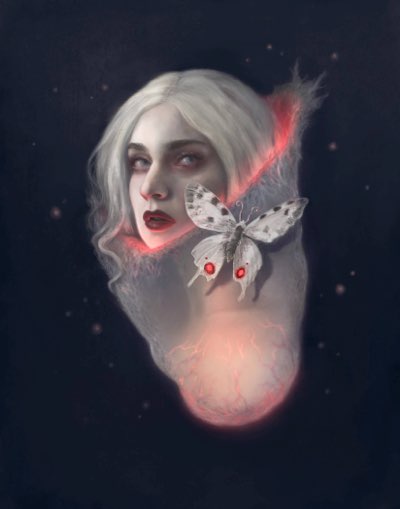
BRADLEY POWERS: Many of your works are inspired or accompanied by poetry. What about poetry inspires you? Which poetry authors really speak to you?
LAUREN RAYE SNOW: I think the poetic exists in the same emotional category for me as music. I’m intensely jealous of musicians, because their work often has a direct effect on the physiology of anyone who encounters it. I have had physiological experiences standing in front of paintings, but it’s a rarer occurrence.
So to answer your question, poetry and poetic prose trigger a bodily response from me. Like the hair on your arm standing on end, or a rush through the nervous system: physiological and also emotional, generally pleasant and often overwhelming. But sometimes less pleasant, like the bottom dropping out when you peer out over a height. Still, I like it, whether it’s pleasant or not. It’s the closest thing I think I experience to the numinous or the sublime.
A favorite author of mine who was an absolute master of this is Angela Carter. The first paragraph of “The Bloody Chamber” is an intense ride for the brain, the heart, and the body. I did an old painting of her crumbling decadent vampire story, “The Lady of the House of Love,” which I no longer include in my publicly available works because it’s not up to my current standards. Maybe someday I’ll come back to that one again.
BP: The cover piece, “Becoming,” and “Strange Agony” are both based on Carmilla by Joseph Sheridan Le Fanu. What other pieces might come out of this series? What about this novella speaks to you?
LRS: “Carmilla is Sexier, More Subversive, and More Relevant to Modern Experience than Dracula; In This Essay I Will …”
One of the overarching themes in my work is a duality, or a dance of opposites; in Carmilla, the opposites at play are attraction and repulsion. The narrator and protagonist, Laura, describes an overwhelming simultaneous sense of both attraction and repulsion in Carmilla’s presence. One wonders how much of the repulsion written on the page was using the moral cover of monstrosity to allow its depiction of queer desire for readers in 1872. I’m not terribly interested in separating that out, however, because I think this supposed contradiction is what makes the story so interesting, and the relationship so compelling. I personally prefer monsters to heroes. They’re more honest. Monsters are a mirror for our subconscious desires.
As for more pieces in the series—yes, I’m already working on more! More paintings, drawings, even book elements, like endpapers. I want to depict Carmilla and Laura together, as well as other moments and motifs from the story, both literal and from the emotional realm of dreams.
BP: “The Ecstasy of St. Joan” and the passages you accompanied it with were illuminating and very powerful. It’s beautiful that you have educated your audience on the injustices that she endured, but you also created a narrative in which she could be herself. Can you explain your thought process about how you’ve chosen to convey her?

LRS: Thank you so much! I have always wanted to paint Joan, who was an early figure of fascination for me (and I think she is for many young girls and queer people). I’ve had an uneasy experience inside my own gender, even when I was quite young, so I suppose I related to and was inspired by her story since she was someone who was not only different, but triumphantly so, even if only for a time, and if only according to the cultural moment she lived in.
My dear friend who modeled for Joan is nonbinary and grew up attending a church named for Joan, which I didn’t know before asking them to model for this painting. We also coincidentally happened to conduct our reference shoot on the day of Joan’s execution. The whole process for making this work felt very serendipitous. Besides Joan’s trial transcript, the tableaus of colorful androgynous saints in the Tarsem Singh-directed R.E.M. video for “Losing My Religion” were also part of my inspiration for the composition.
Much of my work explores themes of religion and religious trauma. When I started the Joan piece, I initially considered going in a much angrier direction. But that felt off almost immediately. Meditating on it, I felt this sadness about how Joan never got to be at ease in herself, or that whatever ease she had was fleeting. In this painting, I wanted to create that ease for her. The types of people who have historically been demonized, scapegoated, persecuted—I want to see them revered.
BP: In “Becoming,” you’ve shown transparency exceedingly well in the chrysalis encapsulating the girl. The technical artistic growth in your works between 2018 and the present is amazing! What tools have you used to grow your skillset as an artist? What have the past three years looked like for you as an artist?
LRS: Thank you! I think my answer for “how to grow” is pretty boring—just keep making work. That has been seriously difficult throughout the pandemic years; I don’t think I’m alone in reporting that it was incredibly isolating and disruptive. My honest assessment of my own work is that I wish I had more of it and that I wish I was farther along than I am now, but I think most artists are their own harshest critics. Involving myself in a community of artists, both mentors and peers, has also been essential. Mentors I’ve learned so much from include Sam Weber, Greg Manchess, and John Picacio; peers in my classes at SmArt School and those I’ve met on the convention circuit have both helped me level up and have helped me to find and keep the joy in creating.
What I would say to any other artist working is that the best time to create is now; that rest, leisure, and peace are a vital part of the creative process; that dissatisfaction is an ally but that shame is an enemy and a paralytic, so learn to recognize the difference between them and take action accordingly.
BP: Several of your works like “Finding” and “Home” are about your home state, Texas, and represent a love/hate type of relationship. How do you so successfully represent duality in your work?
LRS: That’s the dance of opposites again! I think my interest in duality comes from having had a highly dogmatic religious background. These things are allowed, those things are not. These things are sacred, those things are profane. This state is holy, that state is an abomination. Even your thoughts cannot be trusted—they may be the voice of the devil. Cut yourself in two. I think it’s evident that ideologies like these are fertile ground for serious anxiety, and that was certainly the case for me as a young person.
Texas is such a singular place. My own experience as an individual trying to survive in the thrall of an oppressive ideology I feel echoes the larger stories of Texas—its land, its culture, its punishing climate, its history of colonialism and violence and resilience.
Recently I have considered leaving Texas to live elsewhere (though I haven’t yet), and I found myself for the first time feeling protective of Texas. When I travel to other places and tell people I’m from Texas, frequently I hear “oh my god, I’m so sorry.” I have slightly more patience for this response now that Texas and other Republican-led states are heavily persecuting trans children and queer people and criminalizing abortion care. I support anyone who needs to flee their home to protect themselves from physical danger and from violations of their human rights. But the people who live in and have lived in these places are vibrant, resilient, and intelligent; our cultures are rich and beautiful and worthy of celebration. Don’t be sorry that I live in Texas. Speak out from wherever you are—take action against the violent authoritarians oppressing us—and don’t think it can’t happen where you live.
BP: Thank you so much, Lauren, for sharing your work and important perspective! You can find more of Lauren’s work at her website, Twitter, and Instagram.
